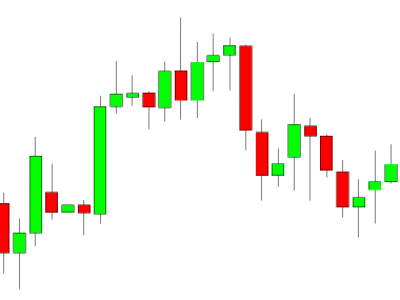5 Trading Tools to Identify The Direction Of A Trend
Why Knowing The Direction Is Important
Trading with the trend is trading with the flow. When the prevailing trend is up, why would you want to look for short entries when buying might result in much smoother trades? Many amateur traders, even when facing a long lasting trend that has been going on for months, can’t stop looking for signs that the trend is over, whereas they could have made so much money by simply joining the trend. Even more important, trading with the trend is independent from your overall trading strategy. Identifying the overall market direction and only trading in that direction can serve as a first filter for your trading strategy.
What Are You Looking For?
Before we start going over how to identify the trend, we should be clear about what we are looking for. Markets can do one of three things: go up, go down, or move sideways.  The picture above shows you the three possible scenarios, but knowing what has happened after the fact is always the easy part. The hard part is finding out what is currently happening when markets are moving in real time and the space on the right is empty – that’s where this article comes in. In what follows we show you 5 ways how you can identify the prevailing trend and the direction. To be clear, the article is not meant to show you how to identify trading entries, but to understand price and trends in a more efficient way.
The picture above shows you the three possible scenarios, but knowing what has happened after the fact is always the easy part. The hard part is finding out what is currently happening when markets are moving in real time and the space on the right is empty – that’s where this article comes in. In what follows we show you 5 ways how you can identify the prevailing trend and the direction. To be clear, the article is not meant to show you how to identify trading entries, but to understand price and trends in a more efficient way.
1. The Simple Way: Line Graph
Most traders only use bars and candles when it comes to observing charts, but completely forget about a very effective and simple tool that would allow them to look through all the clutter: the line graph. The purpose of bars and candles is to provide detailed information about what is happening on your charts, but is this really necessary when it comes to identifying the overall trend? Probably not.  A trader would do well to zoom out from time to time and switch to the line graph to get a better and clearer picture of what is currently happening. And since our only goal is to identify the direction, the line graph is a perfect starting point.
A trader would do well to zoom out from time to time and switch to the line graph to get a better and clearer picture of what is currently happening. And since our only goal is to identify the direction, the line graph is a perfect starting point.
2. Highs and Lows
The next way to identify trend direction is through analyzing highs and lows on your charts. In an uptrend you will see higher highs when price pushes upwards. The swing lows in an uptrend will be higher as well since the dips will be bought and usually do not retrace as deep. Conversely, the highs and lows will be lower in a downtrend signaling declining prices.  Again, it is not too important to get totally lost if you are using the direction just as a filter for your trades. In most cases you should be able to tell relatively quickly whether you are in an uptrend, in a downtrend or in a range.
Again, it is not too important to get totally lost if you are using the direction just as a filter for your trades. In most cases you should be able to tell relatively quickly whether you are in an uptrend, in a downtrend or in a range.
Rule of thumb: If you can’t tell what is happening on your charts quickly, it is usually better to stand aside until you can see clearly again.
3. Moving Averages And How To Use Them
Moving averages are undoubtedly among the most popular trading tools and they are great to identify the market direction as well. However, there are a few things to be aware of when it comes to analyzing trend direction with moving averages. The length of the moving average highly impacts when you get a signal when markets turn. If your moving average is too small (fast), you might get a lot of false signals because it reacts too soon to minor price movements. On the other hand, a fast moving average can get you out early when the trend is about to change. Conversely, a slow moving average might provide signals too late. The picture below illustrates these points further: the black line is the faster 10 period exponential moving average (EMA) and the blue line is the slower 21 period simple moving average (SMA).  (1) The 10 EMA would have signaled a turn from an upward moving market to a downward moving market – clearly too early. The 21 SMA only shows a small reaction when observing the slope. (2) The 10 EMA is very erratic and changes quickly from bullish to bearish signals, and back. In a sideways moving market, a slow moving average will avoid whipsawing trading behavior. (3) Conversely to the first point, the faster moving average would have gotten you out of the short trades much faster than the slower 21 SMA – the 10 EMA started pointing up much earlier than the 21 SMA. As you can see, different moving averages offer different advantages in certain market conditions. In the end it comes down to what you feel comfortable with and what matches your trading style. Furthermore, there are different ways of using moving averages as directional filters. Whereas some traders only look at the slope of the moving average to determine the direction, other traders analyze which side of the moving average price currently is on.
(1) The 10 EMA would have signaled a turn from an upward moving market to a downward moving market – clearly too early. The 21 SMA only shows a small reaction when observing the slope. (2) The 10 EMA is very erratic and changes quickly from bullish to bearish signals, and back. In a sideways moving market, a slow moving average will avoid whipsawing trading behavior. (3) Conversely to the first point, the faster moving average would have gotten you out of the short trades much faster than the slower 21 SMA – the 10 EMA started pointing up much earlier than the 21 SMA. As you can see, different moving averages offer different advantages in certain market conditions. In the end it comes down to what you feel comfortable with and what matches your trading style. Furthermore, there are different ways of using moving averages as directional filters. Whereas some traders only look at the slope of the moving average to determine the direction, other traders analyze which side of the moving average price currently is on.
4. Channels And Trend Lines
Channels and trend lines are another way to identify the direction of a trend, although a trader has to be aware of a few limitations and characteristics when it comes to using trend lines. In contrast to moving averages, trend lines cannot provide early signals when a trend is being established. You need at least two points to draw a trend line and only the third time back at the trend line will tell you how markets actually see the trend line, if they respect it at all. Therefore, using trend lines will provide you with later signals and are more subjective than other tools. Whereas trend lines might be better suited for long term trends and to get a very broad sense of direction, especially new traders will run into problems when using trend lines due to their subjective nature. 
5. How To Use The ADX Indicator
The ADX is an indicator that you could use to determine the direction of the trend. The ADX indicator comes with three lines, the ADX line that tells you the strength of the trend (we deleted this line in our example, since we only want to analyze the direction of the trend), the +DI line which shows the strength of the bullish strength (green line) and the -DI line which shows the bearish strength (red line). As you can see in the graphic below, the ADX signals an uptrend when the green line is on top of the red line, and it signals a downtrend when the red line is higher than the green line. Of course, like any trading tool, the ADX has its limitation as well. When price moves sideways for a while, the ADX shows you whipsawing behavior and unclear signals. No tool will work 100% of the time and it comes down to knowing when to use it, when not to use it and understanding the limitations. Overall, the ADX can provide helpful information about the direction of the trend when you take a look at the screenshot below. 
How To Build A Trading Method: Combining The Tools
As we have seen in the previous article, every tool and concept has its advantages and limitations, and will not work all of the time. However, it is not necessary that you find a way to achieve a 100% winrate when you understand how the concept of the risk reward ratio works. To build a reliable trading strategy you can combine different tools using the benefits of your favorite trading concepts. The attached screenshot shows one possibility how to combine different trading tools such as a moving average, the ADX and the analysis of highs and lows to form a trading methodology. In the end, it comes down to how well you choose your trading tools, how well you understand them and how good you are when it comes to applying them to live market conditions. 







